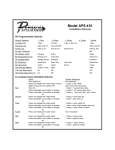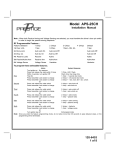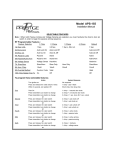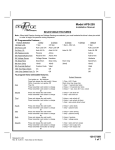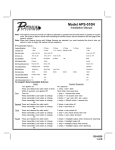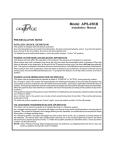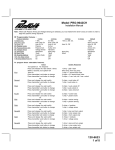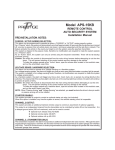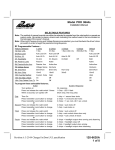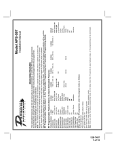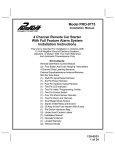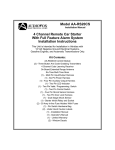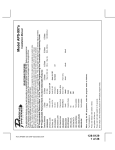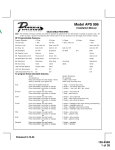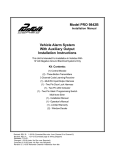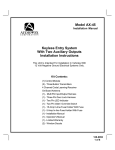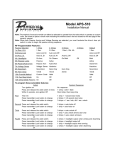Download Audiovox APS-350-A Installation manual
Transcript
Model APS-350-A Installation Manual SELECTABLE FEATURES Note : When both Passive Arming and Voltage Sensing are selected, you must hardwire the driver’s door pin switch in order to begin the passive arming sequence. RF Programmable Features : Feature Selection First Second Third Fourth Fifth Sixth Seventh Eighth 1 Chirp 1 Second Door Locks Auto Lock On Auto Unlock On Passive Door Locks Passive Arm Voltage Sense Horn Chirps On Siren Chirps On 2 Chirps 3.5 Second Door Locks Auto Lock Off Auto Unlock Off Active Door Locks Active Arm Hardwire Horn Chirps Off Siren Chirps Off Default 1 Second Auto Lock Off Auto Unlock Off Active Locks Passive Arm Hardwire On Horn Chirps On Siren Chirps On To program these selectable features; Action System Response Turn ignition on Flip valet switch on then off 3 times Within 3 seconds, turn ignition Off No response 1 Chirp - LED 1 flash Short chirp, then long chirp First LED Response Within 3 seconds, turn ignition On 1 chirp = 1 second door locks 1 Flash Pause... Press transmitter button 1 to change 2 chirps = 3.5 second door locks or Second Flip valet switch on then off 2 chirps = auto locks off 2 Flash Pause... Press tranmitter button 1 to change 1 chirp = auto locks on or Third Flip valet switch on then off 2 chirps = auto unlock off 3 Flash Pause... Press transmitter button 1 to change 1 chirp = auto unlock on or Fourth Flip valet switch on then off 1 chirp = passive locks 4 Flash Pause... Press transmitter button 1 to change 2 chirps = active locks or Fifth Flip valet switch on then off 1 chirp = Passive Arm 5 Flash Pause... Press transmitter button 1 to change 2 chirps = Active Arm or Sixth Flip valet switch on then off 1 chirp = Voltage sense on 6 Flash Pause... Press transmitter button 1 to change 2 chirps = Hardwire or Seventh Flip valet switch on then off 1 chirp = Horn chirps on 7 Flash Pause... Press transmitter button 1 to change 2 chirps = Horn chirps off or Eighth Flip Valet Switch on then off 1 chirp = Siren chirps on 8 Flash Pause... Press transmitter button 1 to change 2 chirps = Siren chirps off or Flip valet switch on then off Exit program mode or Turn ignition key off Exit program mode Note : Once you enter the feature programming mode, do not allow more than 15 seconds to pass between steps, or the programming will be terminated. Page 1 INSTALLATION OF MAJOR COMPONENTS Control Module : Select a mounting location inside the passenger compartment ( up behind the dash ), and secure using the two screws provided. The control module can also be secured in place using cable ties. Do not mount the control module in the engine compartment, as it is not waterproof. You should also avoid mounting the unit directly onto factory installed electronic components. These components may cause RF interference, which can result in poor transmitter range or intermittent operation. Siren : Select a mounting location in the engine compartment that is well protected from access below the vehicle. Avoid areas near high heat components or moving parts within the engine compartment. To prevent water retention, the flared end of the siren must be pointed downward when mounted. Mount the siren to the selected location using the screws and bracket provided. Hood or Trunk Pin Switch : A pin switch is included for use in protecting the hood or trunk ( or hatchback ) of the vehicle. The switch must always be mounted to a grounded, metal surface of the vehicle. It is important to select a location where water cannot flow or collect, and to avoid all drip gutters on hood and trunk fender walls. Choose locations that are protected by rubber gaskets when the hood or trunk lid is closed. The pin switch can be mounted using the bracket provided, or direct mounted by drilling a ¼ “ diameter mounting hole. Keep in mind that when properly mounted, the plunger of the pin switch should depress at least ¼ “ when the hood or trunk lid is closed. Dash Mounted L.E.D. : A small red L.E.D. is included that will serve as a visual indicator of the alarm status. It should be installed in the dash, located where it can be easily seen from outside the vehicle, yet not be distracting to the driver. Once a location has been selected, check behind the panel for wire routing access, and to confirm the drill will not damage any existing components as it passes through the panel. Drill a ¼ “ diameter hole, and pass the red and blue wires from the L.E.D. through the hole, from the front of the panel. Firmly press the body of the L.E.D. into the hole until fully seated. Valet Switch : Select a mounting location for the switch that is easily accessible to the driver of the vehicle. The switch does not have to be concealed, however, concealing the switch is always recommended, as this provides an even higher level of security to the vehicle. The valet switch can be mounted to the lower side of the dash by drilling a ¼ “ diameter hole in the selected location. Be sure to check behind the dash for adequate clearance for the body of the switch, and to confirm that the drill will not damage any existing components as it passes through the dash. You should also make certain that the back of the switch is accessible for wiring later in the installation. Shock Sensor : Select a solid mounting surface for the shock sensor on the firewall inside the passenger compartment, and mount the sensor using the two screws provided. The shock sensor can also be secured to any fixed brace behind the dash using tie straps. Whichever mounting method is selected, make certain that the sensitivity adjustment is accessible for use later in the installation. Page 2 WIRING THE SYSTEM Large 11 Pin Edge Connector : Red Fused Wire : + 12 VDC CONSTANT BATTERY SOURCE This wire controls the sensitivity of the voltage sensing circuit, which detects the turning on of an interior light when a door is opened. It will also detect the switching on of parking or headlamps, and in many cases will trigger the alarm when a thermostatically controlled electronic radiator cooling fan switches on. When installing this system into vehicles with electronic “ after fans “, it is recommended you disable the voltage sense circuit. In voltage sensing applications, the closer to the battery that the red wire is connected, the less sensitive the voltage sense circuitry will be. Moving this connection point to the fuse panel will increase the sensitivity, and connecting to the courtesy lamp fuse in the vehicle will provide maximum sensitivity of the voltage sense circuit. When hardwiring the control module to pin switches at all entry points, the voltage sense circuit must be disabled. Move dip switch # 2 to the off position, then connect the red wire to a + 12 VDC constant battery source. White Wire : + 12 VDC PULSED PARKING LIGHT OUTPUT ( 15 AMP MAX ) This wire is provided to flash the vehicle’s parking lights. Connect the white wire to the positive side of one of the vehicle’s parking lights. Orange Wire : 300 mA GROUND OUTPUT WHEN ARMED - N. C. STARTER DISABLE This wire is provided to control the starter cut relay. Connect the orange wire to terminal 86 of the relay. Connect relay terminal 85 to an ignition wire in the vehicle that is live when the key is in the on and crank positions, and off when the key is in the off position. ( This is where the yellow wire from the alarm should be connected ). Cut the low current starter solenoid wire in the vehicle, and connect one side of the cut wire to relay terminal 87A. Connect the other side of the cut wire to relay terminal 30. Note : This is a normally closed starter cut arrangement, and when power is removed from the security system, the starter disable feature will not operate, allowing the vehicle to start. Audiovox does not recommend using the Orange wire to interrupt anything but the starting circuit of the vehicle. 2 Dark Blue Wires : DELAYED PULSED OUTPUT / CHANNEL 2 ( TRUNK RELEASE ) The dark blue wires are controlled via an independent RF channel from the keychain transmitter. These are the N.O. and COMMON contacts of an on board, 10 Amp relay, so they can be connected to positive or negative switched circuits. Connect one of the dark blue wires to the output of the trunk release pushbutton switch, and the other dark blue wire to either chassis ground, or to a fused + 12 VDC battery source, depending on the polarity of the trunk release circuit in the vehicle. When using this channel for an accessory other than trunk release, connect one dark blue wire to the accessory, and the other dark blue wire to either chassis ground, or, to a fused + 12 volt battery source, depending upon the requirements of the accessory. WARNING ! Never attempt to pull more than 10 Amperes of current through this relay. The circuit will be damaged. Always check the requirements of accessories prior to connecting them to the circuit. Black Wire : CHASSIS GROUND Connect this wire to a solid, metal part of the vehicle’s chassis. Do not confuse this wire with the thin black antenna wire that exits the control module independently. Page 3 2 Dark Green w/ White Trace Wires : ENTRY ILLUMINATION The dark green w/ white trace wires provide the entry lighting, and flash the vehicle’s dome light while the alarm is sounding. These are NO ( normally open ) and COM ( common ) contacts of an on board, 10 Amp maximum relay. Connect one of the dark green w/ white trace wires to the wire in the vehicle that turns on the interior courtesy light. Connect the other dark green w/ white trace wire to either chassis ground if the vehicle switches ground to the courtesy lights, or a fused + 12 volt constant battery source if the vehicle switches 12 volts to the courtesy lights. NOTE : When wiring this feature in vehicles with factory equipped delay lighting circuits, it is best to connect to the output of the timer which feeds the dome light, rather than at the door switch. This will ensure that the dome light pulses when the alarm is triggered. White w/ Black Trace Wire : POSITIVE OUTPUT TO SIREN Route this wire through a rubber grommet in the firewall, and to the siren location. Connect the white / black wire to the positive wire of the siren. Secure the black ground wire of the siren to chassis ground. Black w/White Trace Wire: LOW CURRENT NEGATIVE HORN OUTPUT (300mA MAX CURRENT) The Black w/White trace wire provides a 300mA pulsed output to beep the vehicle's horn. This low current pulsed output should only be connected to the low current switched ground output from the vehicle's horn switch. If the vehicle switches high current ground or + 12 volts to the horn, a relay must be used to operate the vehicle horn. Connect the Black w/White trace wire to terminal #86 of a VF45F11 P&B or equivalent 30 A automotive relay. Connect terminal #85 to a fused + 12 volt source. Connect the remaining relay contacts, 87, 87a, and 30 to perform the switching function the vehicle's horn circuit requires. Mini 6 Pin Edge Connector : Dark Green Wire : ( - ) INSTANT TRIGGER ZONE 2 This is an instant on ground trigger wire. It must be connected to the previously installed hood and trunk pin switches. Brown Wire : - DOOR TRIGGER If the vehicle’s courtesy light switches have a ( - ) ground output when the door is opened ( GM and most Imports ), you must connect this wire to the negative output from one of the door switches. WARNING : Do not use the brown wire if the vehicle has + 12 volt output type door switches. ( see Purple Wire ). Light Green Wire : ( - ) INSTANT TRIGGER ZONE 1 This is an instant on ground trigger wire. This wire ( zone ) should be reserved for connection to optional ground output trigger devices such as motion and / or shock impact sensors. Yellow Wire : + 12 VDC IGNITION SOURCE Connect this wire to a source that is live when the key is in the on and crank positions. Be sure that this source is off when the key is in the off position. Purple Wire : + DOOR TRIGGER If the vehicle’s door courtesy light switches have a + 12 volt output when the door is opened ( most Fords and some Imports ), you must connect this wire to the positive output from one of the door switches. In most cases, the purple wire will only need to be connected to one door switch, no matter how many doors the vehicle has. WARNING : Do not use the purple wire if the vehicle has ground output type door switches. ( see Brown Wire ). Page 4 Dark Green w/ Black Trace Wire : LATCHING OUTPUT / CHANNEL 3 The green w/ black trace wire latches to ground via an independent RF channel from the keychain transmitter. This is a transistorized, low current ( 300 mA ) output, and should only be used to drive an external relay coil. This wire provides an immediate ground signal, and stays at ground for as long as the button(s) on the keychain transmitter remain pressed. WARNING ! Connecting the dark green w/ black trace wire to the high current switched output of trunk release circuits will damage the control module. Connect the dark green w/ black trace wire to terminal 86 of the AS 9256 relay ( or an equivalent 30 Amp automotive relay ), and wire the remaining relay contacts to perform the selected function of channel 3. 2 Pin Blue Connector : VALET SWITCH Route the grey and black wires in the 2 pin connector from the valet switch to the control module, and plug it into the mating blue connector on the side of the module. 2 Pin White Connector : DASH MOUNTED L.E.D. Route the red and blue wires in the 2 pin white connector from the L.E.D. to the control module, and plug it into the mating white connector on the side of the module. 4 Pin White Connector : SHOCK SENSOR Route the red, black, blue, and green wires in the 4 pin white connector from the shock sensor to the control module, and plug one end into the shock sensor, and the other end into the mating white connector on the side of the module. 6 Pin Door Lock Output Connector : NORMAL DOOR LOCK OPERATION The orange, blue w/ white tracer, yellow, white, green, and blue wires in the 6 conductor connector are the contacts of the on board door lock relays. The function of each of these wires is listed below; Lock Relay Unlock Relay Blue w/ White Trace = N.O. Relay Contact Orange = N.O. Relay Contact Dark Green = N.C. Relay Contact Dark Blue = N.C. Relay Contact Yellow = Common Relay Contact White = Common Relay Contact 3 Wire Ground Switched Door Lock Circuits : In these vehicles, the dark green and dark blue door lock wires are not used. The white and yellow wires must be connected to a chassis ground source. The blue w/ white stripe wire is the ground pulse “ lock “ output, and should be connected to the negative lock wire in the vehicle. The orange wire is the ground pulse “ unlock “ output, and should be connected to the negative unlock wire in the vehicle. 3 Wire Positive Switched Door Lock Circuits : In these vehicles, the dark green and dark blue wires are not used. The orange and blue w/ white stripe wires must be connected to a + 12 volt battery source. The yellow wire is the positive pulse “ lock “ output, and should be connected to the positive lock wire in the vehicle. The white wire is the positive pulse “ unlock “ output, and should be connected to the positive unlock wire in the vehicle. 5 Wire Alternating Door Lock Circuits : In this application, it is necessary to cut the existing door lock by - pass wires. These wires run from the master door lock switch to the slave door lock switch, and then on to the door lock motors. Cut the existing lock wire, and connect the yellow wire to the slave switch or motor side of the cut wire. Connect the green wire to the master switch side of the cut wire. Page 5 Cut the existing unlock wire, and connect the white wire to the slave switch or motor side of the cut wire. Connect the blue wire to the master switch side of the cut wire. The orange and blue w/ white stripe wires must be connected to a fused + 12 VDC battery source. Refer to the door lock wiring supplement for proper connection of these wires into the various locking circuits available in current vehicles. 6 Pin Door Lock Output Connector : 2 STEP UNLOCK OPERATION When wiring for 2 step unlock operation, you must connect the outputs of the on board unlock relay to the driver’s door lock motor. Wire these outputs as follows; Orange = N.O. Relay Contact to + 12 VDC Battery Dark Blue = N.C. Relay Contact to Motor leg switch side White = Common Relay Contact to Motor leg motor side Wire the transistorized negative “ all doors unlock “ output directly to the negative unlock wire from the door lock switch in vehicles with 3 wire ground switched circuits. In vehicles with 3 wire positive or 5 wire alternating switched circuits, you must add a 30 Amp automotive relay to provide the “ all doors unlock “ feature. Red w/ Black & Green w/ Black 2 Pin Red Connector : 2 STEP UNLOCK CONNECTOR The green w/ black tracer wire provides a 300 mA ground pulse output for the all doors unlock signal, and can be connected to the negative door unlock wire in 3 wire negative switched vehicles. The red w/ black trace wire provides a + 12 VDC source for those applications that require a relay for the all doors unlock feature. COMPLETING THE INSTALLATION Antenna Wire : Be sure to extend the thin black antenna wire to it’s full length, and cable tie into place where it cannot be damaged. Avoid wrapping this wire around major, high current wire looms. Adjusting the Shock Sensor : The sensitivity of the pre - detect circuit is automatically set 30% less sensitive than the full trigger circuit. Using a small screwdriver, gently turn the adjustment screw fully counterclockwise. ( DO NOT over turn this screw. Maximum rotation for this adjustment is 270° ). Close the hood and trunk lids, and arm the alarm. Wait 6 seconds for the accessories trigger zone to stabilize, then firmly strike the rear bumper with the side of a closed fist considering the amount of force required to break a window. CAUTION : Never perform this test on the vehicle’s glass, as you may break the window. Turn the adjustment screw clockwise ( increasing sensitivity ) about ¼ turn and re - test. Repeat this procedure until the alarm sounds. Ultimately, one firm strike to the rear bumper will cause the alarm to emit pre - detect warning tones. WARNING ! Setting the sensitivity too high can cause false alarms due to noise vibrations from passing trucks and heavy equipment. To decrease sensitivity, turn the adjustment screw counter clockwise. Wire Dressing : Always wrap the alarm wires in convoluted tubing, or with a spiral wrap of electrical tape. Secure these looms along the routing using cable ties. This will ensure that the alarm wires are not damaged by falling onto hot or sharp moving surfaces in the vehicle. Operation : Take a few moments to check off the appropriate option boxes in the owner’s manual, and to fully explain the operation of the system to your customer. Page 6 Audiovox Corp., 150 Marcus Blvd., Hauppauge, N.Y. 11788 128-5082A







